Excerpts from Jim Conrad's
Naturalist Newsletter
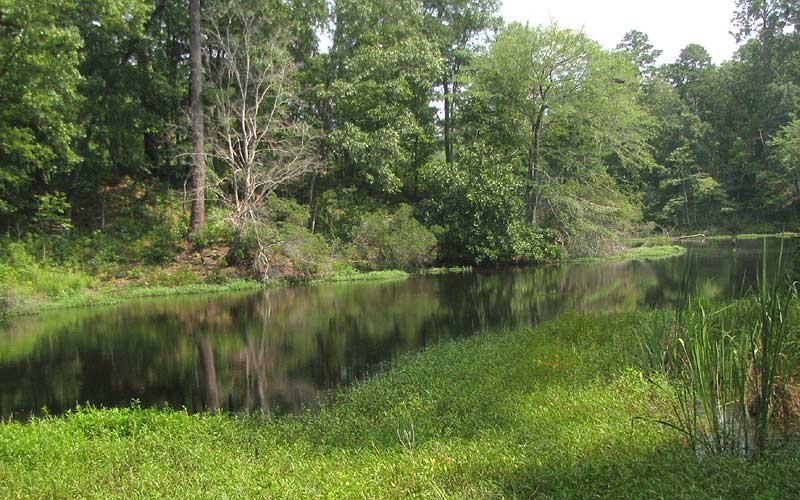
from the the July 1, 2012 Newsletter issued from the woods of the Loess Hill Region a few miles east of Natchez, Mississippi, USA
SWAMP SMARTWEED OVERABUNDANCE
The little beaver-dam lake into which the abandoned, peninsular Pipes Lake Campground {~N31.38°, ~W91.16°, elev. ~140ft (~40m)} extends in nearby Homochitto National Forest is home to beaver, alligators, Anhingas, soft-shelled turtles and other interesting critters, and it's filling with silt. Most of its shoreline is fringed by dense mats of aquatic vegetation, as shown above. At first glimpse I thought that the aquatic plant creating the mats was invasive Alligator Weed, because it can look just like that. However, up close the plant was clearly something else, as shown below:

That's Swamp Smartweed, sometimes called Mild Waterpepper, POLYGONUM HYDROPIPEROIDES, a member of the Buckwheat Family, the Polygonaceae. Polygonum is a big genus, including between 65 and 300 species, depending on your expert. And the experts don't much agree. The online Flora of North America, normally thought of the final authority on these matters, assigns the species to the genus Persicaria (Persicaria hydropiperoides), though most other experts don't seem to accept that. Species in this group are known variously as smartweeds, knotweeds, knotgrass, etc.
A flower close-up is shown below:
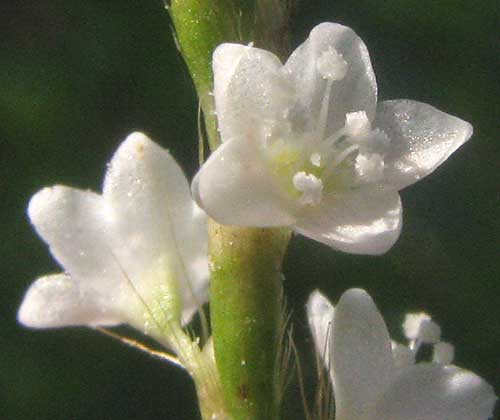
Those flowers show features typical of the genus. First, instead of having the typical colored corolla subtended by a green calyx, the corolla is just one thing looking like a corolla, in which case it's called a perianth, and the lobes are known as tepals. There are eight stamens. You can see how the blossoms arise from bristle-fringed sheaths, called ocreolae, surrounding the stems. Those ocreolae are diagnostic for this family, something important to notice when you're trying to identify things.
Swamp Smartweed produces an abundance of tiny, hard seeds (belonging to the Buckwheat Family, you can imagine what they look like) much appreciated by ducks and other grain-eating birds. However, when the plant creates single-species communities as we see in Pipes Lake, it can reduce overall availability of resources to wildlife needing food and shelter throughout the year, not just when Swamp Smartweed happens to be supplying it.
Despite Swamp Smartweed's weediness, it's a native American species, occurring throughout the US and much of Canada, except in some drier states and provinces in the central area. It also extends through Mexico and Central America into South America, exhibiting many taxonomically confusing variations throughout its vast distribution area.
from the August 3, 2014 Newsletter issued from the Frio Canyon Nature Education Center in the valley of the Dry Frio River in northern Uvalde County, southwestern Texas, on the southern border of the Edwards Plateau; elevation ~1750m (~5750 ft); N29.62°, W99.86°; USA
SWAMP SMARTWEED IN TEXAS
The other day at the sometimes submerged edge of a little ephemeral stream in Cook's Slough Nature Park on Uvalde's south side a smartweed turned up, shown below:
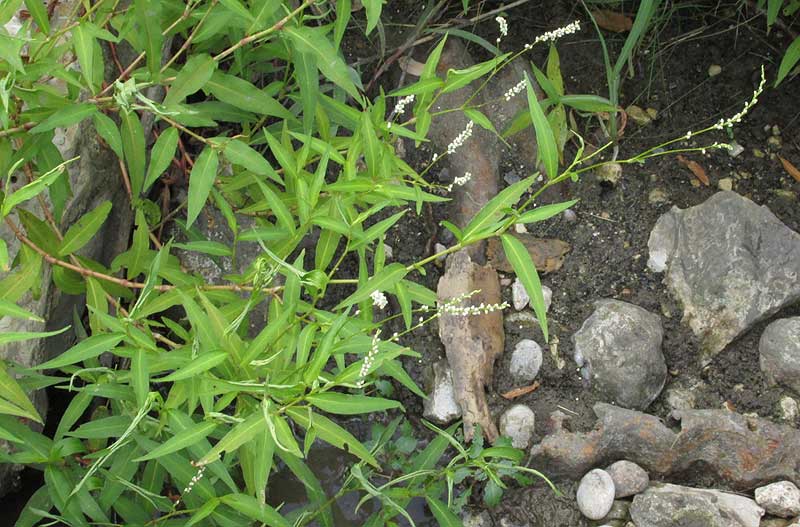
Notice how the stems tend to recline. A close-up of some flowers appears below:

That picture shows an important feature of members of the Buckwheat Family: Instead of the flower having a green calyx below a colorful corolla, there's just one thing like a merged calyx and corolla. In such cases we call the whole structure the perianth, and instead of referring to calyx sepals or corolla petals, "tepals" are spoken of.
Maybe the best field mark of all for the Buckwheat Family, however, is what's shown below:

Notice that where each leaf attaches to the stem, immediately above the connection point a cylindrical membrane surrounds the stem. You can think of that as stipules grown together, stipules being tiny, leaf-like things often at the base of leaves. When stipules grow together into a cylinder around the stem we often say they form a "stipular sheath," but the structure's fancy name is "ocrea." If you find a plant with ocreae, that's a very good sign that you have a member of the Buckwheat Family, though not all genera in the family produce them.
We've seen our Cook's Slough species nearly everyplace we've visited the last few years, but it still always gives a little trouble when I want to be sure it's really what I think it is, and not something closely related. Some very similar species exist, and this one is remarkably variable. It's so variable that throughout its taxonomic history it's been assigned quite a few names by botanists who were certain they'd found a new species, but which turned out just to be a normal variation of this one.
Our plant is the Swamp Smartweed, POLYGONUM HYDROPIPEROIDES, or Persicaria hydropiperoides according to some specialists. You see the two names used about equally. I stick to Polygonum because that's how I learned it.
So, in the field, if you're where the soil at least sometimes is waterlogged or even submerged and you see a smartweed halfway reclining on the ground, its flowering heads are slender, white, and the flowers aren't as closely packed together as in most smartweed species, the flowers' five tepals are not particularly dotted with glands, and the ocreae bear along their top margins hairlike "bristles" up to 10mm long (3/8ths inch), then probably you have our Swamp Smartweed. The tepals numbering five and the longer-than-typical bristles atop the ocreae are especially good field marks.
Swamp Smartweed occurs all across the US and contiguous Canada, except in some high, arid western states, as well as all through Mexico and Central America into South America.
from the September 6, 2009 Newsletter, issued from the Siskiyou Mountains west of Grants Pass, Oregon:
SWAMP SMARTWEED
Up at the pond there's a weedy-looking aquatic emerging from the water and topped by spike-like racemes of little white flowers. You can see it emerging from the pond's surface choked with pondweed below:
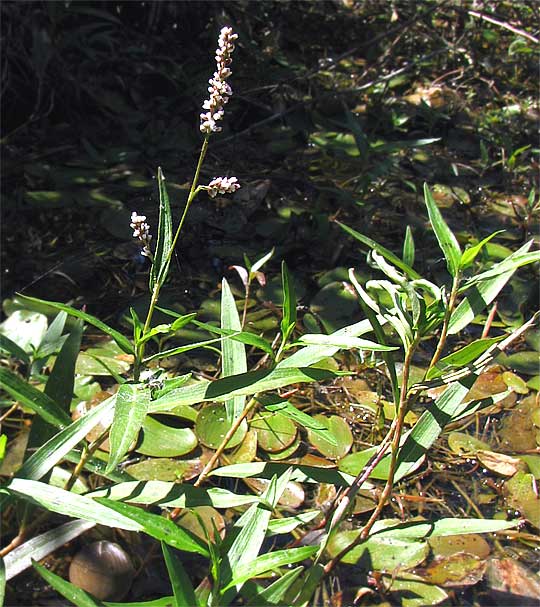
That's Swamp Smartweed, sometimes called Mild Waterpepper, POLYGONUM HYDROPIPEROIDES, and it also grew in the pond below my old hermit trailer back in southwestern Mississippi; it's native coast-to-coast in North America. The flowers, only about 1/10th-inch across (3 mm), are usually white but often suffused with pinkness.
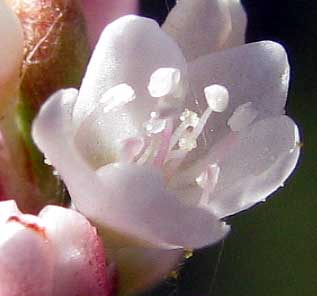
Above you see a blossom with six petal-like perianth lobes (perianth is the combined calyx and corolla), six stamens, and three stigma-topped styles arising from the three-angled ovary hidden down below. Having flower parts in threes or multiples thereof is a little unusual for dicot flowers, but fairly common in the Buckwheat Family. Most dicot flower parts occur in 5s or 4s, or multiples thereof.
The Buckwheat Family is known by another good field mark that's even visible on non-flowering plants. You can see it on our Swamp Smartweed, looking like a papery, bristle-topped, brown sleeve surrounding the stem at the base of a leaf petiole, below:
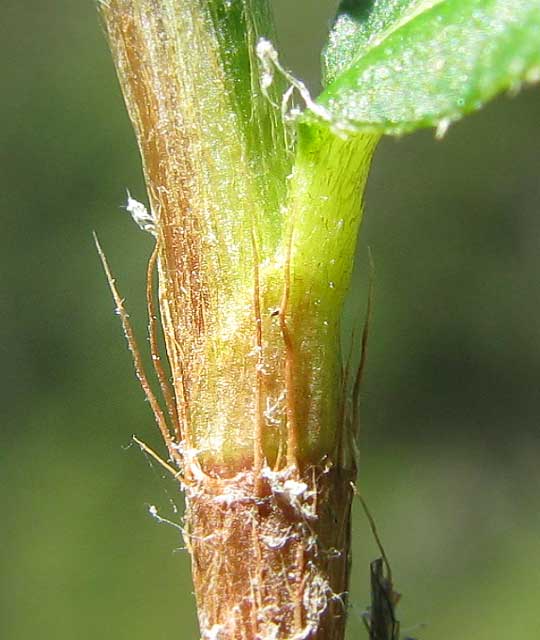
We've often referred to the tiny-leaflike stipules at the base of certain leaves, such as the earlike, gland-rimmed ones we saw on a willow stem last week. In the Buckwheat Family the stipules have grown together into that cylindrical sheath surrounding the stem at nodes ("stem joints"). Often these sheaths bear at their tops conspicuous hairlike features like those in the photo. Such a sheath at a stem node is known technically as an ocrea (plural, ocreae).
Swamp Smartweed stems are weak, often branched affairs growing through the water, often issuing white roots at their nodes. The plants are perennial, arising from rhizomes. The plants' 0.08-inch long (2 mm), hard, brown, shiny, three-cornered fruit, an achene, is a mainstay duck food, and other birds and small animals eat them, too.